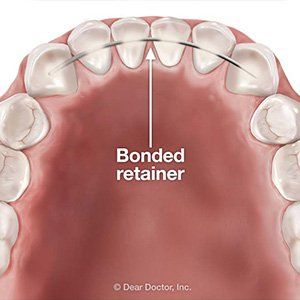Why a Bonded Retainer Might be a Better Choice After Braces
A lot of time and effort goes into straightening your smile. But there’s a possibility it might not stay that way—and all that hard work could be lost. The same natural mechanism that enables your teeth to move with braces could cause them to revert to their old, undesirable positions.
So for a little while (or longer for some people) you’ll need to wear a retainer, an appliance designed to keep or “retain” your teeth where they are now. And while the removable type is perhaps the best known, there’s at least one other choice you might want to consider: a bonded retainer.
Just as its name implies, this retainer consists of a thin metal wire bonded to the back of the teeth with a composite material. Unlike the removable appliance, a bonded retainer is fixed and can only be removed by an orthodontist.
Bonded retainers have several advantages. Perhaps the most important one is cosmetic—unlike the removable version, others can’t see a bonded retainer since it’s hidden behind the teeth. There’s also no keeping up with it—or losing it—since it’s fixed in place, which might be helpful with some younger patients who need reminding about keeping their retainer in their mouth.
There are, however, a few disadvantages. It’s much harder to floss with a bonded retainer, which could increase the risks of dental disease. It’s also possible for it to break, in which case it will need to be repaired by an orthodontist and as soon as possible. Without it in place for any length of time the teeth could move out of alignment.
If you or a family member is about to have braces removed, you’ll soon need to make a decision on which retainer to use. We’ll discuss these options with you and help you choose the one—removable or bonded—that’s right for you.
If you would like more information on bonded retainers, please contact us or schedule an appointment for a consultation.







